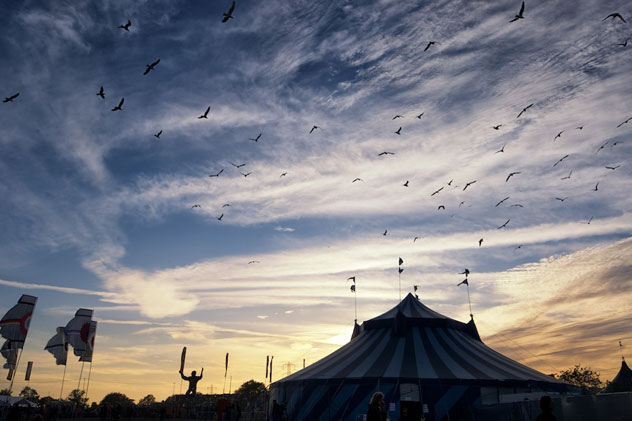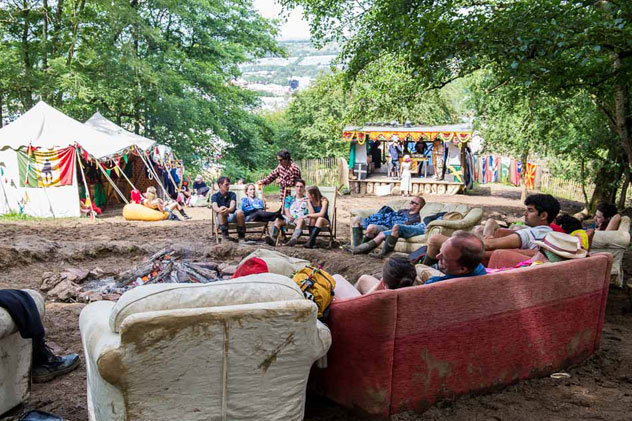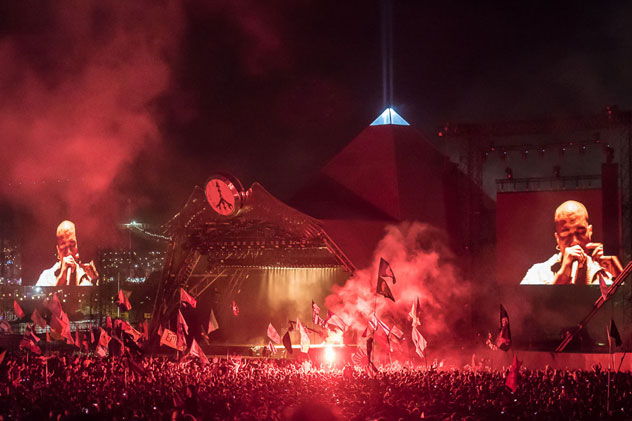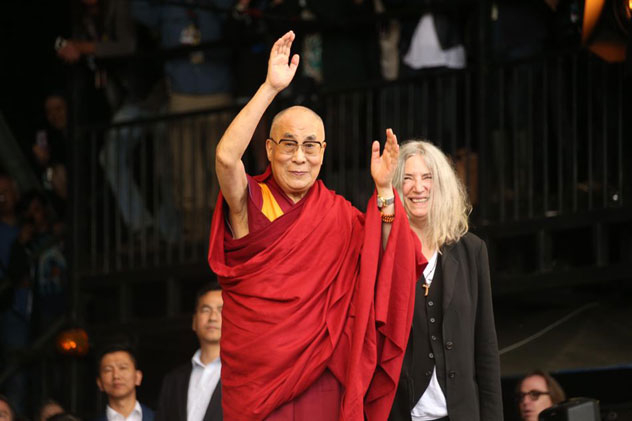- Let's get one thing straight: reviewing Glastonbury is a futile exercise. Rating it out of five feels trivial. No, the famed British weekender offers so much to so many that a one-person account is never going to do it justice. Unlike other festivals, where there might be four or five arenas and a handful of must-see artists, Glastonbury is a world unto itself, a city of tents, stalls and stages of seemingly infinite cultural, social and political offering. Your weekend might be music-focussed, but it could just as easily revolve around poetry, theatre, comedy or holistic healing. It's important, then, to acknowledge that the following is simply my experience.
As a music journalist and someone who loves watching big acts on big stages, this year was heavily skewed towards Glastonbury's vast and varied musical programme. Rock and pop still dominated the main stages in 2015, but it felt like electronic music held a presence like never before. Rudimental, Deadmau5 and The Chemical Brothers, for example, all headlined consecutive nights at the Other Stage, the festival's second arena, and almost every dive, shack or rave-hole you entered after dark was pumping out some rampant club hybrid.
 The festival opens its gates on Wednesday morning, but it's not until Thursday that the schedule starts to take shape. Most of what's on offer is electronic, with many of the site's smaller venues hosting DJs from the morning through 2 or 3 AM. Glastonbury is at 90% capacity come Thursday evening, so there's a rabid sense of first-night excitement tearing through the grounds. Apollonia, J.E.S.U.S (AKA, Jackmaster, Eats Everything, Skream and Seth Troxler) and Gerd Janson all had slots this year, but I ended up at a Deviation showcase at the Stonebridge Bar, where Martelo and Benji B cut furiously through golden-era dubstep, vintage house and the latest grime bangers. The festival hadn't officially opened and I was already enjoying one of the best nights out I'd had in ages.
Glastonbury is huge, so you have to be tactical with how and where you pass your time. If you're there for the music, most of the action takes place in and around a central cluster of fields, between which people spend their days wandering leisurely. Friday brought with it the early promise of rain, and sure enough it poured just as Brazilian keyboardist Marcos Valle was hitting his stride at West Holts, the trendiest and most diverse of the main stages. It rained again during Mary J. Blige's afternoon turn on the Pyramid, but by this time the crowd were so enrapt by her pitch-perfect renditions of "Real Love" and "No More Drama" they barely noticed. Later on the same stage, indie darlings The Libertines rattled romantically through their greatest hits, before Hot Chip closed out West Holts with a heartfelt cover of Bruce Springsteen's "Dancing In The Dark."
The festival opens its gates on Wednesday morning, but it's not until Thursday that the schedule starts to take shape. Most of what's on offer is electronic, with many of the site's smaller venues hosting DJs from the morning through 2 or 3 AM. Glastonbury is at 90% capacity come Thursday evening, so there's a rabid sense of first-night excitement tearing through the grounds. Apollonia, J.E.S.U.S (AKA, Jackmaster, Eats Everything, Skream and Seth Troxler) and Gerd Janson all had slots this year, but I ended up at a Deviation showcase at the Stonebridge Bar, where Martelo and Benji B cut furiously through golden-era dubstep, vintage house and the latest grime bangers. The festival hadn't officially opened and I was already enjoying one of the best nights out I'd had in ages.
Glastonbury is huge, so you have to be tactical with how and where you pass your time. If you're there for the music, most of the action takes place in and around a central cluster of fields, between which people spend their days wandering leisurely. Friday brought with it the early promise of rain, and sure enough it poured just as Brazilian keyboardist Marcos Valle was hitting his stride at West Holts, the trendiest and most diverse of the main stages. It rained again during Mary J. Blige's afternoon turn on the Pyramid, but by this time the crowd were so enrapt by her pitch-perfect renditions of "Real Love" and "No More Drama" they barely noticed. Later on the same stage, indie darlings The Libertines rattled romantically through their greatest hits, before Hot Chip closed out West Holts with a heartfelt cover of Bruce Springsteen's "Dancing In The Dark."
 As soon as the curtains fall on the bands, the crowds go one of two ways: back to their tents or off to the site's South-East corner. The festival's dedicated afterhours area is a dark and labyrinthine tangle of tiny plots, with names like The Unfairground, Hell and Block 9. I've only ever visited this zone at night and under the influence, so navigating it is a perpetual challenge. Most people end up in Block 9, either at Genosys or NYC Downlow, but there's a lot more besides. In the early hours of Saturday morning, I flitted from Bez's Acid House, where the man himself was cutting wiry shapes to Slam's "Positive Education" and Joey Beltram's "Energy Flash," to The Temple for Neil Landstrumm's rude techno. It all ended, though, dancing arm-in-arm at NYC Downlow, while rows of drag-queens can-canned to James Hillard's flowery disco.
Musically, what sets Glastonbury apart from its peers is the overwhelming sense of occasion, and the money-can't-buy moments that arise as a result. Most of Saturday bumbled by in a sleep-deprived haze, soundtracked by brief, woozy stints seeing Ibeyi, Herbert and Gregory Porter. They all had their moments—Porter's "Musical Genocide," in particular—but it wasn't until Kanye West took to the Pyramid just after 10 PM that Saturday really caught fire. His performance was equal parts sloppy and spectacular, and just as divisive as we all predicted. Even West, an artist seemingly above the music industry and its conventions, used this coveted slot to court his latest controversy, twice informing the throng that they were watching "the greatest living rock star on the planet!" Many hated his set, but I didn't hear anyone say they wished they'd seen someone else.
As soon as the curtains fall on the bands, the crowds go one of two ways: back to their tents or off to the site's South-East corner. The festival's dedicated afterhours area is a dark and labyrinthine tangle of tiny plots, with names like The Unfairground, Hell and Block 9. I've only ever visited this zone at night and under the influence, so navigating it is a perpetual challenge. Most people end up in Block 9, either at Genosys or NYC Downlow, but there's a lot more besides. In the early hours of Saturday morning, I flitted from Bez's Acid House, where the man himself was cutting wiry shapes to Slam's "Positive Education" and Joey Beltram's "Energy Flash," to The Temple for Neil Landstrumm's rude techno. It all ended, though, dancing arm-in-arm at NYC Downlow, while rows of drag-queens can-canned to James Hillard's flowery disco.
Musically, what sets Glastonbury apart from its peers is the overwhelming sense of occasion, and the money-can't-buy moments that arise as a result. Most of Saturday bumbled by in a sleep-deprived haze, soundtracked by brief, woozy stints seeing Ibeyi, Herbert and Gregory Porter. They all had their moments—Porter's "Musical Genocide," in particular—but it wasn't until Kanye West took to the Pyramid just after 10 PM that Saturday really caught fire. His performance was equal parts sloppy and spectacular, and just as divisive as we all predicted. Even West, an artist seemingly above the music industry and its conventions, used this coveted slot to court his latest controversy, twice informing the throng that they were watching "the greatest living rock star on the planet!" Many hated his set, but I didn't hear anyone say they wished they'd seen someone else.
 On Sunday, punk icon Patti Smith would trump West on several counts, beginning by inviting the Dalai Lama onstage for a crowd-led rendition of "Happy Birthday" and a slice of cake. She then dropped the softly-spoken facade and growled her way through cult hit "Gloria," during which she slipped and fell. Quickly getting back on her feet, she grabbed the mic and screamed "I fell on my ass at Glastonbury, because I'm a fucking animal!" The words were barely out of her mouth before she took to ripping out the strings of her guitar with her teeth. I only caught the second half, but it was easily the most compelling, human performance of the weekend. Not even Lionel Richie and The Who's Pete Townshend could match her charisma and energy.
Sunday night drew to a close with two storming techno sets courtesy of Der Klang Der Familie's Sven Von Thülen and Robert Hood, both under the stars at Genosys. Then, it was up to the Stone Circle for one last roll-around with the festival's battlers and freaks, beating away apocalyptic thoughts of packed-up tents and sad, departing coaches. Last year, I wrote a gushing recap of Glastonbury that tried to convey why it's so many people's favourite festival. I've since realised that that was a near impossible task. The reasons are many and complex, and personal to each individual. You could, though, boil it all down to one simple idea: it just makes a lot of people very happy.
On Sunday, punk icon Patti Smith would trump West on several counts, beginning by inviting the Dalai Lama onstage for a crowd-led rendition of "Happy Birthday" and a slice of cake. She then dropped the softly-spoken facade and growled her way through cult hit "Gloria," during which she slipped and fell. Quickly getting back on her feet, she grabbed the mic and screamed "I fell on my ass at Glastonbury, because I'm a fucking animal!" The words were barely out of her mouth before she took to ripping out the strings of her guitar with her teeth. I only caught the second half, but it was easily the most compelling, human performance of the weekend. Not even Lionel Richie and The Who's Pete Townshend could match her charisma and energy.
Sunday night drew to a close with two storming techno sets courtesy of Der Klang Der Familie's Sven Von Thülen and Robert Hood, both under the stars at Genosys. Then, it was up to the Stone Circle for one last roll-around with the festival's battlers and freaks, beating away apocalyptic thoughts of packed-up tents and sad, departing coaches. Last year, I wrote a gushing recap of Glastonbury that tried to convey why it's so many people's favourite festival. I've since realised that that was a near impossible task. The reasons are many and complex, and personal to each individual. You could, though, boil it all down to one simple idea: it just makes a lot of people very happy.
 Photo credit: Andrew Allcock (lead, couches), Max Ellis (sky), Charles Gervais (Kanye West), Jason Bryant (Dalai Lama)
Photo credit: Andrew Allcock (lead, couches), Max Ellis (sky), Charles Gervais (Kanye West), Jason Bryant (Dalai Lama)
 The festival opens its gates on Wednesday morning, but it's not until Thursday that the schedule starts to take shape. Most of what's on offer is electronic, with many of the site's smaller venues hosting DJs from the morning through 2 or 3 AM. Glastonbury is at 90% capacity come Thursday evening, so there's a rabid sense of first-night excitement tearing through the grounds. Apollonia, J.E.S.U.S (AKA, Jackmaster, Eats Everything, Skream and Seth Troxler) and Gerd Janson all had slots this year, but I ended up at a Deviation showcase at the Stonebridge Bar, where Martelo and Benji B cut furiously through golden-era dubstep, vintage house and the latest grime bangers. The festival hadn't officially opened and I was already enjoying one of the best nights out I'd had in ages.
Glastonbury is huge, so you have to be tactical with how and where you pass your time. If you're there for the music, most of the action takes place in and around a central cluster of fields, between which people spend their days wandering leisurely. Friday brought with it the early promise of rain, and sure enough it poured just as Brazilian keyboardist Marcos Valle was hitting his stride at West Holts, the trendiest and most diverse of the main stages. It rained again during Mary J. Blige's afternoon turn on the Pyramid, but by this time the crowd were so enrapt by her pitch-perfect renditions of "Real Love" and "No More Drama" they barely noticed. Later on the same stage, indie darlings The Libertines rattled romantically through their greatest hits, before Hot Chip closed out West Holts with a heartfelt cover of Bruce Springsteen's "Dancing In The Dark."
The festival opens its gates on Wednesday morning, but it's not until Thursday that the schedule starts to take shape. Most of what's on offer is electronic, with many of the site's smaller venues hosting DJs from the morning through 2 or 3 AM. Glastonbury is at 90% capacity come Thursday evening, so there's a rabid sense of first-night excitement tearing through the grounds. Apollonia, J.E.S.U.S (AKA, Jackmaster, Eats Everything, Skream and Seth Troxler) and Gerd Janson all had slots this year, but I ended up at a Deviation showcase at the Stonebridge Bar, where Martelo and Benji B cut furiously through golden-era dubstep, vintage house and the latest grime bangers. The festival hadn't officially opened and I was already enjoying one of the best nights out I'd had in ages.
Glastonbury is huge, so you have to be tactical with how and where you pass your time. If you're there for the music, most of the action takes place in and around a central cluster of fields, between which people spend their days wandering leisurely. Friday brought with it the early promise of rain, and sure enough it poured just as Brazilian keyboardist Marcos Valle was hitting his stride at West Holts, the trendiest and most diverse of the main stages. It rained again during Mary J. Blige's afternoon turn on the Pyramid, but by this time the crowd were so enrapt by her pitch-perfect renditions of "Real Love" and "No More Drama" they barely noticed. Later on the same stage, indie darlings The Libertines rattled romantically through their greatest hits, before Hot Chip closed out West Holts with a heartfelt cover of Bruce Springsteen's "Dancing In The Dark."
 As soon as the curtains fall on the bands, the crowds go one of two ways: back to their tents or off to the site's South-East corner. The festival's dedicated afterhours area is a dark and labyrinthine tangle of tiny plots, with names like The Unfairground, Hell and Block 9. I've only ever visited this zone at night and under the influence, so navigating it is a perpetual challenge. Most people end up in Block 9, either at Genosys or NYC Downlow, but there's a lot more besides. In the early hours of Saturday morning, I flitted from Bez's Acid House, where the man himself was cutting wiry shapes to Slam's "Positive Education" and Joey Beltram's "Energy Flash," to The Temple for Neil Landstrumm's rude techno. It all ended, though, dancing arm-in-arm at NYC Downlow, while rows of drag-queens can-canned to James Hillard's flowery disco.
Musically, what sets Glastonbury apart from its peers is the overwhelming sense of occasion, and the money-can't-buy moments that arise as a result. Most of Saturday bumbled by in a sleep-deprived haze, soundtracked by brief, woozy stints seeing Ibeyi, Herbert and Gregory Porter. They all had their moments—Porter's "Musical Genocide," in particular—but it wasn't until Kanye West took to the Pyramid just after 10 PM that Saturday really caught fire. His performance was equal parts sloppy and spectacular, and just as divisive as we all predicted. Even West, an artist seemingly above the music industry and its conventions, used this coveted slot to court his latest controversy, twice informing the throng that they were watching "the greatest living rock star on the planet!" Many hated his set, but I didn't hear anyone say they wished they'd seen someone else.
As soon as the curtains fall on the bands, the crowds go one of two ways: back to their tents or off to the site's South-East corner. The festival's dedicated afterhours area is a dark and labyrinthine tangle of tiny plots, with names like The Unfairground, Hell and Block 9. I've only ever visited this zone at night and under the influence, so navigating it is a perpetual challenge. Most people end up in Block 9, either at Genosys or NYC Downlow, but there's a lot more besides. In the early hours of Saturday morning, I flitted from Bez's Acid House, where the man himself was cutting wiry shapes to Slam's "Positive Education" and Joey Beltram's "Energy Flash," to The Temple for Neil Landstrumm's rude techno. It all ended, though, dancing arm-in-arm at NYC Downlow, while rows of drag-queens can-canned to James Hillard's flowery disco.
Musically, what sets Glastonbury apart from its peers is the overwhelming sense of occasion, and the money-can't-buy moments that arise as a result. Most of Saturday bumbled by in a sleep-deprived haze, soundtracked by brief, woozy stints seeing Ibeyi, Herbert and Gregory Porter. They all had their moments—Porter's "Musical Genocide," in particular—but it wasn't until Kanye West took to the Pyramid just after 10 PM that Saturday really caught fire. His performance was equal parts sloppy and spectacular, and just as divisive as we all predicted. Even West, an artist seemingly above the music industry and its conventions, used this coveted slot to court his latest controversy, twice informing the throng that they were watching "the greatest living rock star on the planet!" Many hated his set, but I didn't hear anyone say they wished they'd seen someone else.
 On Sunday, punk icon Patti Smith would trump West on several counts, beginning by inviting the Dalai Lama onstage for a crowd-led rendition of "Happy Birthday" and a slice of cake. She then dropped the softly-spoken facade and growled her way through cult hit "Gloria," during which she slipped and fell. Quickly getting back on her feet, she grabbed the mic and screamed "I fell on my ass at Glastonbury, because I'm a fucking animal!" The words were barely out of her mouth before she took to ripping out the strings of her guitar with her teeth. I only caught the second half, but it was easily the most compelling, human performance of the weekend. Not even Lionel Richie and The Who's Pete Townshend could match her charisma and energy.
Sunday night drew to a close with two storming techno sets courtesy of Der Klang Der Familie's Sven Von Thülen and Robert Hood, both under the stars at Genosys. Then, it was up to the Stone Circle for one last roll-around with the festival's battlers and freaks, beating away apocalyptic thoughts of packed-up tents and sad, departing coaches. Last year, I wrote a gushing recap of Glastonbury that tried to convey why it's so many people's favourite festival. I've since realised that that was a near impossible task. The reasons are many and complex, and personal to each individual. You could, though, boil it all down to one simple idea: it just makes a lot of people very happy.
On Sunday, punk icon Patti Smith would trump West on several counts, beginning by inviting the Dalai Lama onstage for a crowd-led rendition of "Happy Birthday" and a slice of cake. She then dropped the softly-spoken facade and growled her way through cult hit "Gloria," during which she slipped and fell. Quickly getting back on her feet, she grabbed the mic and screamed "I fell on my ass at Glastonbury, because I'm a fucking animal!" The words were barely out of her mouth before she took to ripping out the strings of her guitar with her teeth. I only caught the second half, but it was easily the most compelling, human performance of the weekend. Not even Lionel Richie and The Who's Pete Townshend could match her charisma and energy.
Sunday night drew to a close with two storming techno sets courtesy of Der Klang Der Familie's Sven Von Thülen and Robert Hood, both under the stars at Genosys. Then, it was up to the Stone Circle for one last roll-around with the festival's battlers and freaks, beating away apocalyptic thoughts of packed-up tents and sad, departing coaches. Last year, I wrote a gushing recap of Glastonbury that tried to convey why it's so many people's favourite festival. I've since realised that that was a near impossible task. The reasons are many and complex, and personal to each individual. You could, though, boil it all down to one simple idea: it just makes a lot of people very happy.
 Photo credit: Andrew Allcock (lead, couches), Max Ellis (sky), Charles Gervais (Kanye West), Jason Bryant (Dalai Lama)
Photo credit: Andrew Allcock (lead, couches), Max Ellis (sky), Charles Gervais (Kanye West), Jason Bryant (Dalai Lama)